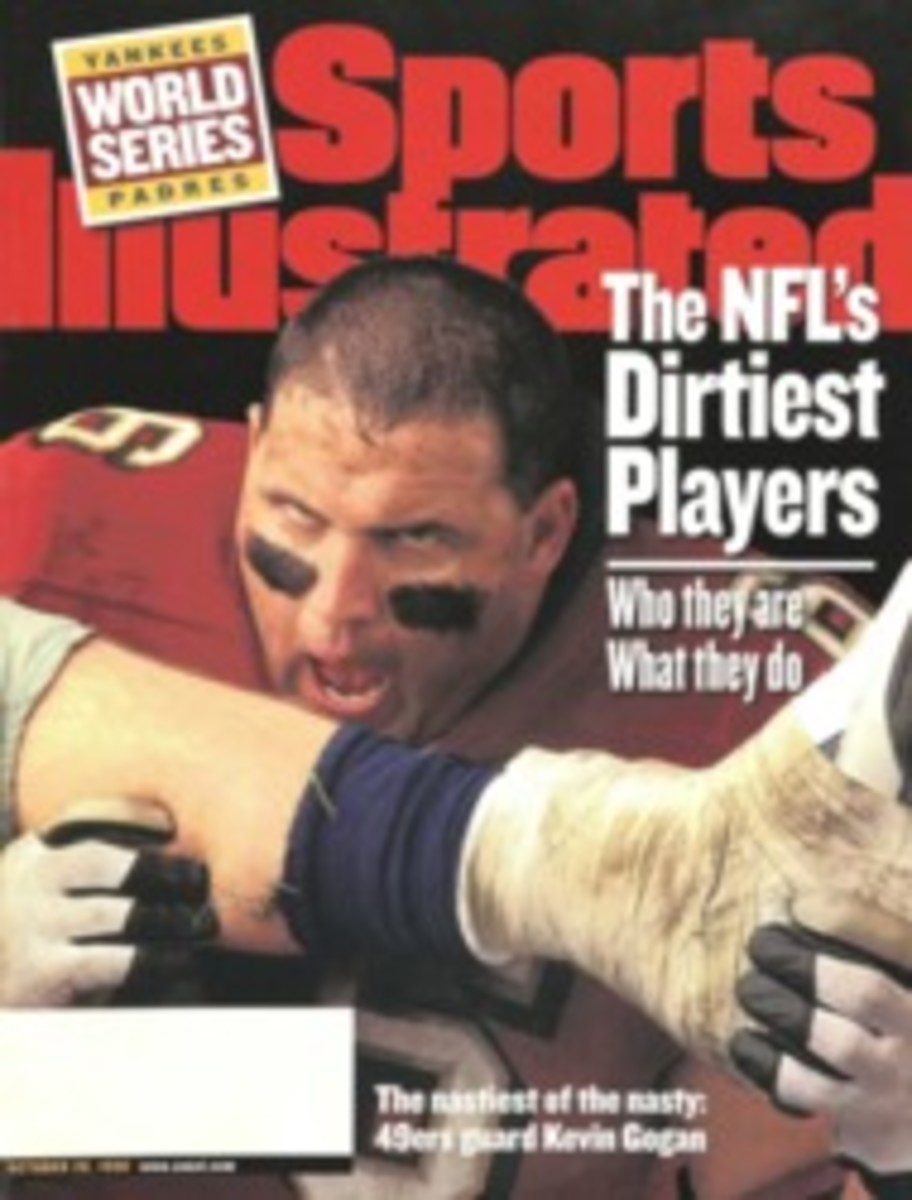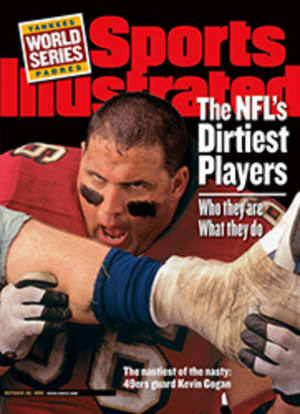
The Monster Hulking Capitals goaltender Olaf Kolzig, a.k.a. Godzilla, has not only shed his backup status but has also emerged as one of the NHL's premier players by finally taming his ferocious temper
There had been almost a quarter century of hockey purgatory, of
squandered playoff series, of short springs pungent with the
smell of disaster. In a suburban dungeon of an arena outside a
city where the only two sports that mattered were pro football
and political football, the Washington Capitals were the NHL's
unloved child, a nice enough team, sure, but a forsaken one.
Then last fall the Caps moved into a new arena downtown, into
the gut of the city, if not quite into its soul, and by season's
end they were storming to the Stanley Cup finals. Throughout
their miraculous run, one creature towered over everything. Yes,
there really is a Godzilla.
His name is Olaf Kolzig. He has been called Godzilla since 1992,
when he was tagged with the nickname by fans because of his size
(now 6'3", 225 pounds) and temper. Kolzig might well have earned
the moniker for his horrifying record in his first six NHL
seasons (14-36-8). But last year, at age 27, he transformed
himself from a career backup with a reputation for finding a way
to lose into what Washington coach Ron Wilson calls "one of the
top five goalies in the league, easy."
Before the Montreal Canadiens' back-to-back games against
Washington and the Buffalo Sabres last weekend, Canadiens coach
Alain Vigneault likened the prospect of meeting Kolzig and
two-time MVP Dominik Hasek on consecutive nights to a baseball
team's facing Kevin Brown one evening and Greg Maddux the next.
Kolzig, who stopped 25 shots in a 2-2 tie with Montreal last
Friday, didn't even try to suppress a grin when told of
Vigneault's comment. "That's better than being Mitch Williams,"
Kolzig said, "like I was a few years ago."
Kolzig used to be the Wild Thing in the net, and the reason he
was in contention for the Conn Smythe Trophy last spring and the
reason he's off to a terrific start this season (through Sunday
he was 2-1-1 with a 1.48 goals-against average and one shutout)
is that he finally tamed his savage instincts. Kolzig found that
by controlling himself he could master others. He curbed his
hotheadedness and became an elite goalie. "Curbed? Did you say
curbed?" Capitals backup goalie Rick Tabaracci asks in mock
surprise. "How closely have you been watching?"
O.K., so Godzilla hasn't turned into Barney. But Kolzig, who
once could have supplied enough kindling to fire up every
barbecue in Georgetown with all his splintered sticks, has
broken just one since training camp began last month. He smashed
it over the crossbar at the end of a practice last week, a
justifiable reaction considering that teammates Kelly Miller and
Mark Tinordi, not exactly the Great One and Super Mario, had
just slipped two shots over his glove, the same spot where the
Detroit Red Wings' Doug Brown beat Kolzig in a 3-2 Washington
loss the night before.
You mess with Godzilla at your peril, even when he's a two-inch
computer-generated image on giant-screen television. When
PlayStation reps brought one of their video games to the
Capitals' practice rink three days before the season opener,
defenseman Joe Reekie challenged Kolzig: Reekie's Team Canada,
starring Raymond Bourque, versus Kolzig's Team Germany, starring
Olaf Kolzig. "Naturally I give the puck to Bourque, and he beats
Olie with a slap shot," Reekie says. "Olie gets angry, and when
I'm not looking, he punches me in the shoulder."
"True," says Kolzig, a South African-born German citizen who
moved with his family to Canada when he was four. "In this game,
you have to pay the price."
For years Kolzig paid a steep price for his combative nature. He
always wanted to play extraordinarily well, and he would beat
himself up when he didn't. He was Washington's first-round draft
choice in June 1989, played his first NHL game four months later
at age 19 and never considered himself a career backup, even as
he rode the pine. But he unwittingly developed a backup's
mentality: After allowing a bad goal, he'd fear that he'd have
to wait weeks for another chance to play. Kolzig had an
opportunity to win the starting job going into the 1995-96
season, after the Capitals traded Don Beaupre, but Washington
opened the lockout-shortened campaign 2-8-2. A hot minor league
goalie, Jim Carey, was summoned to Washington and wound up
winning the Vezina Trophy that season. Carey couldn't catch a
cold in the playoffs the next two years, while Kolzig had three
wins and a 1.87 goals-against average, but Kolzig's reckless
style and snits made him too unreliable to be No. 1.
In September 1996 then Capitals coach Jim Schoenfeld, now behind
the bench for the Phoenix Coyotes, was blunt: He told Kolzig
that temper tantrums in practice were hurting him and disrupting
the Caps. "That was a wake-up call," Kolzig says. "I realized I
didn't have too many chances left to play in the NHL. I started
to channel my competitiveness more, but it got tough playing
only once every few weeks, and I went back to taking out my
frustrations. If you're a forward or a defenseman, you can let
out your frustrations by running someone or shooting the puck as
hard as you can. I thought maybe I was playing the wrong
position."
Wilson, who succeeded Schoenfeld in June 1997, tried a different
tack. After one stick-smashing incident in last year's training
camp, Wilson skated by Kolzig and kiddingly told him he looked
like a big jerk. Soon Washington players were chiming in with a
chorus of good-natured abuse. "He deserved the ridicule of his
teammates," Wilson says. "They got to him, and they enjoyed
getting to him because those volcanic eruptions were funny.
Olie's a funny guy. I just wanted him to focus on the puck, but
he was more worried about everyone's reaction to him. He cared
more about what Joe Reekie thought than stopping the puck."
Kolzig needed to grow thicker skin. He also needed help from the
only man in hockey who seemed to believe in him. Last year
Capitals general manager George McPhee hired an owlish,
soft-spoken hockey itinerant named Dave Prior as Washington's
goalie instructor. Prior had met Kolzig in 1989, when Prior was
with NHL Central Scouting and Kolzig was playing junior hockey
in the Western League. They became reacquainted in the summer of
'96, when Prior was a consultant to Germany's World Cup team and
Kolzig was making his international debut.
Prior liked Kolzig's size and agility but wanted to make him
play bigger. Kolzig, who's a butterfly-style goalie, had always
stationed himself three or four feet outside the crease even
though with his girth he could have blotted out the net by
playing at the top of the crease. He also would follow his
wanderlust after rebounds instead of setting himself to stop the
next shot. Prior had Kolzig play deeper and cut down on his
roaming. "People looked at him and wondered why he couldn't win,
why he couldn't be a Number 1," Prior says. "He just needed some
adjustments."
Kolzig also needed another chance, one that came in the first
period of Washington's 1997-98 opener when starter Bill Ranford
was struck in the groin by a shot. For the next three weeks, as
Ranford rehabilitated his injury and auditioned for the Vienna
Boys' Choir, the Capitals had no option but Kolzig. He never
relinquished the job, winning 33 matches, going to the All-Star
Game and putting together a 2-0 record for Germany in the Nagano
Olympics. Kolzig's only slump came immediately after the Games,
when he lost five straight starts. "I thought that maybe the run
was over," Kolzig says, "and wondered if I might be a flash in
the pan."
The dip occurred when Prior was out of town. When Prior
returned, he ran a videotape that convinced Kolzig he'd been
playing better than his record indicated. Prior also
repositioned him closer to the net. Kolzig finished the regular
season with an 11-3-1 surge, and some Caps began calling Prior
Moses for having led Kolzig out of the wilderness.
For a franchise that had almost consigned itself to being
destiny's doormats--"You came to believe that this organization
was cursed when the playoffs came around," Kolzig says--the
serendipity of Godzilla's cinematic release last spring, when
Kolzig was leading the Caps to the Cup finals, was too good to
be true. Washington might be a little fuzzy on hockey, but it
can spot a good story. MCI Center was suddenly populated with
blowup Godzilla dolls. Kolzig, nearly impeccable with a .941
save percentage and four shutouts while outplaying Hasek in the
Eastern Conference finals, became the face of the Capitals'
long-awaited success. He was glib, witty and handsome. He was
also extroverted, a trait he ascribes to his upbringing. Olaf
grew up as a hotel brat (his father, Axel, worked as a
food-and-beverage manager for hotel chains) and lived a
bedouin-and-breakfast existence, moving 23 times in 28 years. He
knew how to make friends, and he made plenty of new ones with
his performance last season. "Olie became our backbone," Reekie
says. "Everyone in the dressing room liked him because he was so
intense, and people who saw him interviewed on TV liked him
because they could tell he was genuine. Olie was just one of the
guys you root for."
Now whenever Godzilla looks as though he might erupt in
practice, Wilson skates over to egg him on. Kolzig ignores
Wilson's taunts, refusing to give him the satisfaction of a
tantrum. If he sticks to his nonaggression policy, he'll end up
resembling the green plush Godzilla he keeps in his truck
(license plate: ZILLA), one that looks more likely to nuzzle its
victims than stomp them.
COLOR PHOTO: PHOTOGRAPH BY ANTONIN KRATOCHVIL [Olaf Kolzig]
COLOR PHOTO: LOU CAPOZZOLA Washington monument Butterfly goalie Kolzig looms large in the eyes of opposing shooters. [Olaf Kolzig and opposing player in game]
"People looked at him and wondered why he couldn't win," says
Prior. "He just needed some adjustments."

